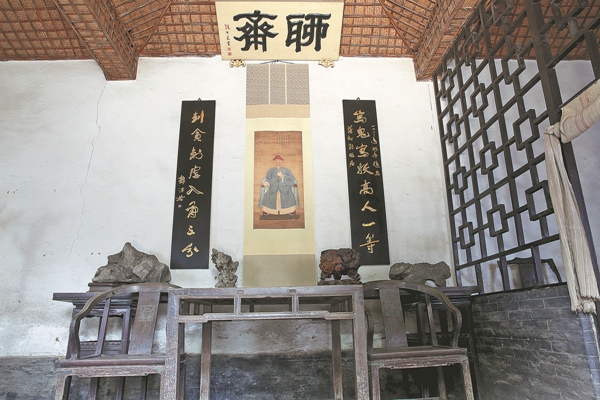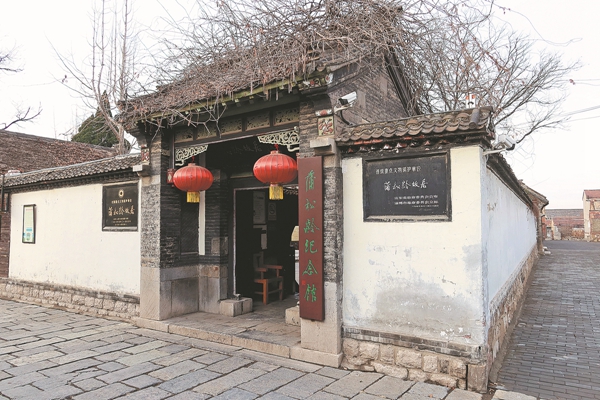
A portrait of Pu Songling, author of Liaozhai Zhiyi, or Strange Tales from the Liaozhai Studio, hangs on the wall in the main building of the Pu Songling Memorial Hall in Zhibo, Shandong province. SUN LILI/FOR CHINA DAILY
Local govt's efforts to preserve Pu Songling Memorial Hall pay off as visitors flock in to appreciate cultural charm
The expanded former residence of Pu Songling, a writer of the Qing Dynasty (1644-1911), has become a popular destination for tourists to appreciate the charm of traditional Chinese culture thanks to the local government's efforts to preserve cultural heritage sites and integrate them into people's lives.
The residential complex, which reopened to the public on Aug 4 after partial expansion and renovation, had received more than 184,000 visitors by the end of the month, a large increase compared with the same period in previous years, said Sun Lili, a worker at the Pu Songling Memorial Hall.
Liaozhai Zhiyi, or Strange Tales from the Liaozhai Studio, a collection of classical Chinese stories authored by Pu, has been translated into more than 20 foreign languages, making it one of the most widely translated and available classic Chinese literary works in foreign countries, said Sun.
Pu's former residence, located in Pujiazhuang, a village in Zibo, Shandong province, consists of the main "Liaozhai" building in center and two adjacent wing rooms, built in typical architectural styles of northern China in the Ming (1368-1644) and Qing dynasties.
The Pu Songling Memorial Hall, a building complex based on the residence, was built in 1980 with the local government's support to display Pu's legacy. Preservation work is undertaken annually to protect the buildings.
The State Administration of Cultural Heritage has issued policies urging governments and social groups to promote the preservation and utilization of cultural relics.
In May, the administration, the Ministry of Culture and Tourism and the National Development and Reform Commission jointly released a notice encouraging local cultural and tourism authorities to include immovable cultural relics in a relics-themed tourism route, a national project that is under construction, and to gradually open these relics to the public.
In recent years, more efforts have been made to preserve the writer's residence.
"The first thing I do every day is to check the condition of each house. Because they are all old houses, we pay special attention to preservation," Sun said.
Some have thatched roofs, so they need to undergo regular inspections.
"We repair them once a year and replace what is needed every three years, because sometimes birds take away materials for their nests, and heavy rains can wash away parts of the thatching," Sun said.
In addition, a restoration project for Pu's residence was begun in May to solve some prominent issues, such as leakage and structural tilting. It was the first of its kind since the structure was rebuilt.
The restoration is committed to using original materials, forms, craftsmanship and techniques, in order to maintain the historical appearance, said Pei Tao, director of the memorial hall.
For instance, the ceilings of the "Liaozhai" main building were woven by hand, using stems or leaves of cattails, which helps preserve its original appearance and can also protect against insects.
The memorial hall has 10 exhibition rooms, displaying more than 15,000 cultural relics, including the only real portrait of Pu, his manuscripts, seals and other national first-class cultural relics.
The exhibition areas also display valuable historical materials, such as ancient copies, foreign language versions, calligraphic works by renowned artists and colored sculptures depicting stories from the collection.
Sun said the memorial hall is advancing the revitalization and utilization of ancient sites by integrating research, education and tourism.
This year, the museum has organized over 10 cultural promotion events at schools, communities and workshops, contributing significantly to the preservation, inheritance and utilization of intangible cultural heritage such as Liaozhai liqu, which came into being through the creative efforts of Pu Songling.
Pu composed lyrics for his stories using popular folk tunes of his time. These Liaozhai liqu, a form of folk music, involve storytelling and theatrical performances, and are recognized as national-level intangible cultural heritage.
Pu Zhangjun, the 11th-generation descendant of Pu Songling, said that in the past, most people read the collection of tales out of curiosity, but now an increasing number of individuals are exploring the profound wisdom and deep philosophical insights it holds.
An example is the hit song Luocha Haishi (A Market in a Faraway Land), recently written and performed by Chinese pop singersongwriter Daolang.
The lyrics of Luocha Haishi are adapted from a Liaozhai Zhiyi tale of the same name, which talks about a man's adventure in a faraway kingdom called Luocha.

The memorial hall is a national cultural heritage site. CHINA DAILY
The song has attracted a large number of tourists to Pu Songling's former residence in the hope of learning more about the tale and the writer.
The continuous influx of visitors in Pu's hometown is a result of the area's wealth of human history and cultural heritage, said Wang Chenguang, a professor at Shandong University's School of Economics.
Wang suggested that the local government should seize this opportunity to develop tourism products and projects that align with the demands of the modern market.
Sun said the memorial hall is creating an immersive themed exhibition room that uses cutting-edge digital technologies such as 5G, 3D, VR and ultra-high definition to allow visitors to immerse themselves in the profound experience of the ghost stories.
Liu Chuan contributed to this story.